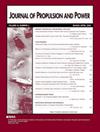Quasi-Two-Dimensional Simulation of a Rotating Detonation Engine Combustor and Injector
IF 2.4
4区 工程技术
Q2 ENGINEERING, AEROSPACE
引用次数: 1
Abstract
A numerical simulation of an annular rotating detonation engine with stoichiometric hydrogen–oxygen is performed. A generic, well-posed, and easily implemented approach using a quasi-two-dimensional method to model the area variations through the rotating detonation engine’s injector and combustor is presented. The detonation–injector interaction is studied for the case with a ratio of four between the combustor and injector’s throat areas. A shock wave is formed in the divergent portion of the injector due to the high backpressure created by the detonation in the combustor. A Favre-averaged steady-state analysis of stream lines and particle paths reveals that the shock causes an irrecoverable loss of stagnation pressure. Stagnation pressure gain in the combustor is insufficient to make up for the loss, and the flow leaves the engine with lower stagnation pressure than in the plenum.旋转爆震发动机燃烧室和喷油器的准二维仿真
对具有化学计量氢-氧的环形旋转爆震发动机进行了数值模拟。提出了一种通用的、定态良好的、易于实现的准二维方法来模拟旋转爆震发动机喷油器和燃烧室的面积变化。研究了燃烧室与喷油器喉道面积比为4的情况下爆轰与喷油器的相互作用。由于燃烧室内爆震产生的高背压,在喷油器的发散部分形成激波。流线和粒子路径的favre平均稳态分析表明,冲击会导致不可恢复的停滞压力损失。燃烧室的滞止压力增益不足以弥补损失,气流离开发动机时的滞止压力比在静压室中的低。
本文章由计算机程序翻译,如有差异,请以英文原文为准。
求助全文
约1分钟内获得全文
求助全文
来源期刊

Journal of Propulsion and Power
工程技术-工程:宇航
CiteScore
4.20
自引率
21.10%
发文量
97
审稿时长
6.5 months
期刊介绍:
This Journal is devoted to the advancement of the science and technology of aerospace propulsion and power through the dissemination of original archival papers contributing to advancements in airbreathing, electric, and advanced propulsion; solid and liquid rockets; fuels and propellants; power generation and conversion for aerospace vehicles; and the application of aerospace science and technology to terrestrial energy devices and systems. It is intended to provide readers of the Journal, with primary interests in propulsion and power, access to papers spanning the range from research through development to applications. Papers in these disciplines and the sciences of combustion, fluid mechanics, and solid mechanics as directly related to propulsion and power are solicited.
 求助内容:
求助内容: 应助结果提醒方式:
应助结果提醒方式:


